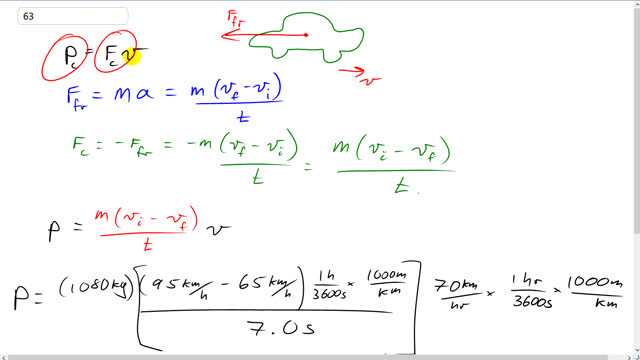
A driver notices that her 1080-kg car, when in neutral, slows down from 95 km/h to 65 km/h in about 7.0 s on a flat horizontal road. Approximately what power (watts and hp) is needed to keep the car traveling at a constant 80 km/h?

In order to watch this solution you need to have a subscription.
This is Giancoli Answers with Mr. Dychko. When this car is traveling at a constant 80 kilometers an hour, the power exerted by its engine is gonna be the force exerted by the car times its constant speed of 80. So, what we need to figure out what is this force that's required. And that's gonna be equal to the friction force that's applied to the car. Now, in this picture, I have only the friction force shown and I don't have the force of the car shown because this is the picture for when the car is coasting in neutral because we have some data about that. We know that it starts at 95 kilometers per hour and slows down to 65 kilometers per hour, in 7 seconds. And, we'll use that information to figure out what the force of friction must be on the car, in order to cause that deceleration. So, force of friction is mass times acceleration. So that's mass times final speed of the car minus initial speed divided by time. And the force applied by the engine of the car, when it's actually going at constant speed and not coasting, is gonna be equal, in magnitude, to this friction force that we are calculating now. So, the friction force is is m v f minus v i over t; and we'll put a negative sign in front of that because now we are calculating force exerted by the car, when it's going at constant speed. And so that's gonna be m times, switch the sides, switch the order of the v i and the v f around, in order to get rid of this minus sign. Here it looks a little bit more clean to have this minus sign distributed into these brackets here so v f becomes negative and v i becomes positive. So, we have m v i minus v f over t. That's what we'll substitute in for the force of the car. So, P is this whole thing times the constant speed of 80 kilometers an hour, v. So, we have P is 1080 times 95 kilometers an hour minus 65 kilometers an hour and then converting that into meters per second by multiplying by 1 hour for every 3600 seconds and times by 1000 meters per kilometer. So, the kilometers cancel there and the hours cancel here and we are left with meters per second on top. And then divide by 7 seconds. And then multiply that by 70 kilometers per hour, also converted into meters and seconds units. And we end up with not this here, we end up with about 29000 watts would be the power of the car. And there we go.
You’ve got 70km/h in your work, but it’s 80km/h in the problem and your calculator!
Nice catch! I'll mention this error in the final answer. Thanks again for reporting it.
isn’t power = work/time?
how did you get P=F•V?
You can write it either way, actually. Pulling apart "Work", you can write it as "Force times distance". In equation form that looks like , distance over time is speed, so you arrive at .
All the best,
Mr. Dychko